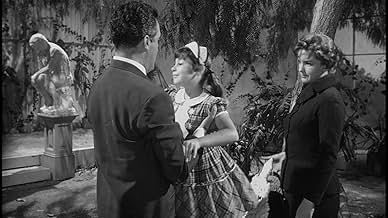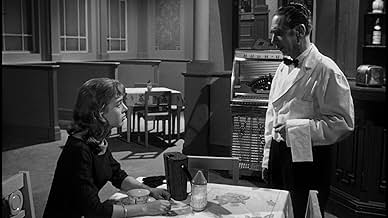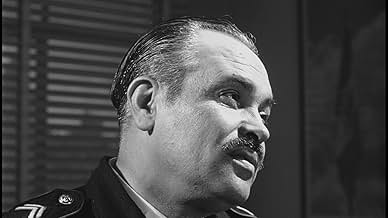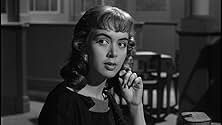VALUTAZIONE IMDb
5,8/10
721
LA TUA VALUTAZIONE
Aggiungi una trama nella tua linguaGraverobbers stumble upon the tomb of a vampire, who turns them into zombies to do his bidding, which is to stalk and capture beautiful women.Graverobbers stumble upon the tomb of a vampire, who turns them into zombies to do his bidding, which is to stalk and capture beautiful women.Graverobbers stumble upon the tomb of a vampire, who turns them into zombies to do his bidding, which is to stalk and capture beautiful women.
- Regia
- Sceneggiatura
- Star
Ariadne Welter
- Marta González
- (as Ariadna Welter)
Germán Robles
- Count Karol de Lavud
- (as German Robles)
Yerye Beirute
- Barraza
- (as Yeire Beirute)
Lourdes Azcarraga
- Víctima de vampiro
- (non citato nei titoli originali)
Irma Castillón
- Niña en hospital
- (non citato nei titoli originali)
Jorge Chesterking
- Turista museo
- (non citato nei titoli originali)
Felipe del Castillo
- Mesero
- (non citato nei titoli originali)
Jesús Gómez Murguía
- Policía
- (non citato nei titoli originali)
Carlos Hennings
- Turista museo
- (non citato nei titoli originali)
José Muñoz
- Comandante policía
- (non citato nei titoli originali)
Carlos Robles Gil
- Turista museo
- (non citato nei titoli originali)
Recensioni in evidenza
Like Miami's Ivan Tors, K. Gordon Murray (his nickname was 'Kagey' for his initials) conducted all of his English dubbing at Florida's Soundlab studios in Coral Gables before making a mint with not just horror entries but a series of children's films such as "Rumpelstiltskin," "Little Red Riding Hood" and "Santa Claus," often performing narration himself. Universal's 1931 Spanish language "Dracula" was a huge success south of the border, but as a film industry the genre didn't truly take off until the 1950s, and while most think of masked wrestlers battling the Universal monsters 1957's "The Vampire's Coffin" and its predecessor were serious takes on the undead, though this sequel lacked the atmospheric setting of "The Vampire" ('Dracula set on a hacienda'), the first half located in a modern but deserted hospital, the rest dividing time between musical numbers in a theater and a shadowy wax museum. Mere weeks after "El Vampiro" premiered in October 1957, producer Abel Salazar was already shooting the follow up, rejoined by three more cast members for their second go round, including ingenue Adriadne Welter as Martha and Alicia Montoya as Martha's Aunt Mary, foiled by two grave robbers who steal the body of German Robles' Count Lavud, the stake still protruding from his heart, moving the coffin to the local hospital where Marion (Carlos Ancira) works with Salazar's Henry. His partner in crime (Yerye Beirute) is employed at the local wax museum, greedily sneaking back in to steal the Count's medallion, but in removing the stake restores the vampire to vengeful life, again casting a spell upon pretty Martha while also attacking a preteen girl in her hospital bed, and a streetwalker who fails to outrun the old bat. German Robles looks more comfortable in his second outing and proves ready for another shot, soon to arrive with the Nostradamus quartet. The urban milieu is no match for the isolation of "The Vampire," but at least this time Salazar actually dispatches his adversary, in bat form as well. Already typecast as thugs, Yerye Beirute would be familiar with Boris Karloff fans in both "Fear Chamber" and "Incredible Invasion," plus "Bring Me the Vampire" and Lon Chaney's "La Casa del Terror."
Dr. Enrique Saldivar (Abel Salazar) once again has to protect Marta González (Ariadne Welter) after evil vampire Count Karol de Lavud (Germán Robles) is brought back to life.
Director Fernando Méndez's sequel to his previous year's El Vampiro features many of the same cast playing the same characters, and yet it isn't anywhere near as successful as the first film, lacking the original's wonderful gothic atmosphere, despite beginning promisingly with a howl of a wolf and a spot of grave-robbing.
The bulk of the action takes place in a hospital and a theatre, neither location possessing the ominous vibe of the original's run-down rural hacienda with its secret passageways and creepy family crypt. Worse still, the theatre location leads to some dreadfully choreographed dance numbers with Welter looking bored and confused throughout.
Thankfully, Méndez saves the best for last, with a fun battle between Enrique and the count in what must be Mexico's worst wax museum: not only are the exhibits totally unrecognisable (they have the characters' names pinned to them so that visitors aren't left guessing), but all of the props are real and potentially lethal. This means that there are sharp axes and spears for weapons, as well as a fully functional guillotine and a 'Virgin of Nuremberg', an iron maiden filled with very sharp spikes.
After escaping being bitten by Lavud (in rubber bat form, suspended on very visible wires), Enrique eventually manages to pin the vampire to the wall with a spear, while Marta narrowly avoids having her head chopped off by the guillotine.
4.5/10, generously rounded up to 5 for IMDb.
Director Fernando Méndez's sequel to his previous year's El Vampiro features many of the same cast playing the same characters, and yet it isn't anywhere near as successful as the first film, lacking the original's wonderful gothic atmosphere, despite beginning promisingly with a howl of a wolf and a spot of grave-robbing.
The bulk of the action takes place in a hospital and a theatre, neither location possessing the ominous vibe of the original's run-down rural hacienda with its secret passageways and creepy family crypt. Worse still, the theatre location leads to some dreadfully choreographed dance numbers with Welter looking bored and confused throughout.
Thankfully, Méndez saves the best for last, with a fun battle between Enrique and the count in what must be Mexico's worst wax museum: not only are the exhibits totally unrecognisable (they have the characters' names pinned to them so that visitors aren't left guessing), but all of the props are real and potentially lethal. This means that there are sharp axes and spears for weapons, as well as a fully functional guillotine and a 'Virgin of Nuremberg', an iron maiden filled with very sharp spikes.
After escaping being bitten by Lavud (in rubber bat form, suspended on very visible wires), Enrique eventually manages to pin the vampire to the wall with a spear, while Marta narrowly avoids having her head chopped off by the guillotine.
4.5/10, generously rounded up to 5 for IMDb.
Graverobbers stumble upon the tomb of a vampire, who turns them into zombies to do his bidding, which is to stalk and capture beautiful women.
Dear Abel Salazar, you are an amazing actor with a great face. I wish you had been better-known to American horror audiences. Films like this, and especially "The Brainiac", have either been forgotten or became cult classics far too late.
When people speak of foreign horror, they often talk of Italian, or sometimes Japanese. These days Korean horror has become more fashionable, and the latest wave (as of 2015) is New Zealand. But who is out there blowing the trumpet for Mexico?
Dear Abel Salazar, you are an amazing actor with a great face. I wish you had been better-known to American horror audiences. Films like this, and especially "The Brainiac", have either been forgotten or became cult classics far too late.
When people speak of foreign horror, they often talk of Italian, or sometimes Japanese. These days Korean horror has become more fashionable, and the latest wave (as of 2015) is New Zealand. But who is out there blowing the trumpet for Mexico?
Mondo Macabro's R2 DVD of this film's prequel, THE VAMPIRE (1957), had included stills from the follow-up excerpted from its photo-novel edition (apparently included in full as a DVD-ROM extra on Casa Negra's 2-Disc R1 Set "The Vampire Collection"); at the time, the synopsis had felt contrived and, therefore, I had anticipated that the film itself would be inferior to the original (though I'm still disappointed that there's no Audio Commentary to accompany it!). Having watched THE VAMPIRE'S COFFIN now - and re-acquainted myself with its predecessor (the very first Mexican horror effort I'd seen), which didn't disappoint - I can only confirm this!
Anyway, the original was largely set at a dilapidated hacienda in a remote village - with characters dressed in old-style clothing and an overpowering foggy atmosphere - so that it was jarring to see these same characters (or who was left standing among them) transposed to modern city surroundings! Apparently, the film-makers purposely opted to make the sequel as different as possible to its predecessor - and, while that same Gothic mood is felt on occasion, the three main settings of the film, i.e. hospital, wax museum and burlesque theater, elicit their own particular ambiance with which the vampire character may not always be compatible (for instance, he appears outside a bar to stalk an aspiring young female performer incongruously dressed in his traditional cape...and, yet, she never for a moment suspects his true intentions, in fact welcomes the stranger's advances by throwing flirtatious glances at him herself)!
The music score is typically overstated (as far as I can tell replicating that of the original, where it seemed to work better!) and the special effects pretty ropey - especially the very visible wires holding the supposedly flying bat, but also the number of times that the vampire is seen reflected in a mirror when it's made clear that he shouldn't!; that said, the transition from vampire to bat is, once again, neatly enough done. The most atmospheric moments are those set in the wax museum with its numerous torture devices (though the climax is a rather awkward mess!), and the large shadows thrown by the vampire on the various buildings in the afore-mentioned stalking sequence (in fact, the film-makers seem to have liked this effect so much that the scene is absurdly extended, when the vampire could very easily have rendered himself invisible at any moment and let the girl simply fall into his clutches - as he does, eventually!). Resting largely on the shoulders of lead/producer Abel Salazar, the comic relief comes off remarkably well (particularly in scenes where he has to explain his tall tale about disappearing coffins and rampaging vampires to his superiors or the police) and, in fact, my relative disappointment with the film isn't due to any intrinsic campiness - as was the case with THE BRAINIAC (1962), for instance - though, as per reviews I've read of the English-dubbed U.S. version prepared by K. Gordon Murray (included on the DVD but which I haven't checked out), it's a different matter altogether!
As for the principal cast members, Salazar is, again, an engaging hero; likewise, Ariadne Welter is lovely throughout (even when engaged in a sleazy dance number!) - but German Robles fares less well than in the first film (where he had cut a suitably imposing figure), here tending to come off as merely nonchalant...and a veritable Elvis Costello look-alike to boot! The evidently rushed production, then, ultimately brings (perhaps unkind) comparisons - with respect to the difference in quality between the two films - to SON OF KONG (1933) when stacked up against its monumental prequel!
Anyway, the original was largely set at a dilapidated hacienda in a remote village - with characters dressed in old-style clothing and an overpowering foggy atmosphere - so that it was jarring to see these same characters (or who was left standing among them) transposed to modern city surroundings! Apparently, the film-makers purposely opted to make the sequel as different as possible to its predecessor - and, while that same Gothic mood is felt on occasion, the three main settings of the film, i.e. hospital, wax museum and burlesque theater, elicit their own particular ambiance with which the vampire character may not always be compatible (for instance, he appears outside a bar to stalk an aspiring young female performer incongruously dressed in his traditional cape...and, yet, she never for a moment suspects his true intentions, in fact welcomes the stranger's advances by throwing flirtatious glances at him herself)!
The music score is typically overstated (as far as I can tell replicating that of the original, where it seemed to work better!) and the special effects pretty ropey - especially the very visible wires holding the supposedly flying bat, but also the number of times that the vampire is seen reflected in a mirror when it's made clear that he shouldn't!; that said, the transition from vampire to bat is, once again, neatly enough done. The most atmospheric moments are those set in the wax museum with its numerous torture devices (though the climax is a rather awkward mess!), and the large shadows thrown by the vampire on the various buildings in the afore-mentioned stalking sequence (in fact, the film-makers seem to have liked this effect so much that the scene is absurdly extended, when the vampire could very easily have rendered himself invisible at any moment and let the girl simply fall into his clutches - as he does, eventually!). Resting largely on the shoulders of lead/producer Abel Salazar, the comic relief comes off remarkably well (particularly in scenes where he has to explain his tall tale about disappearing coffins and rampaging vampires to his superiors or the police) and, in fact, my relative disappointment with the film isn't due to any intrinsic campiness - as was the case with THE BRAINIAC (1962), for instance - though, as per reviews I've read of the English-dubbed U.S. version prepared by K. Gordon Murray (included on the DVD but which I haven't checked out), it's a different matter altogether!
As for the principal cast members, Salazar is, again, an engaging hero; likewise, Ariadne Welter is lovely throughout (even when engaged in a sleazy dance number!) - but German Robles fares less well than in the first film (where he had cut a suitably imposing figure), here tending to come off as merely nonchalant...and a veritable Elvis Costello look-alike to boot! The evidently rushed production, then, ultimately brings (perhaps unkind) comparisons - with respect to the difference in quality between the two films - to SON OF KONG (1933) when stacked up against its monumental prequel!
The Vampire's Coffin (1957)
*** (out of 4)
A doctor steals the corpse of vampire Count Lavud (German Robles) and soon those from the first film who destroyed him must try to do so again. Once again the Count is after Marta (Ariadna Welter) but Dr. Saldivar (Abel Salazar) is there to try and save the day.
This sequel to EL VAMPIRO is actually a lot better and manages to be one of the better vampire movies from this period. The movie fixes a lot of the problems with the first movie and manages to be a lot more entertaining thanks in large part to a nice atmosphere, a much better flow to the picture as well as some nice performances. The film kicks off with a great grave robbing sequence, which was obviously influenced by FRANKENSTEIN MEETS THE WOLF MAN but it's still a lot of fun.
From here we get a lot of very good scenes that manage to pack some nice atmosphere and of course the fog machine is on overdrive during most scenes. There's some very good stuff inside the hospital where two doctors debate on science and the idea of stealing the vampire's corpse. I thought the attack scenes were all extremely good and there's no doubt that the flow is much better here. The film manages to go by rather quickly and this certainly helps.
Another benefit is that the three leads are all very good. Robles is excellent as the vampire and manages to be quite menacing. Welter isn't given as much to do here as she did in the original but it's still nice seeing her return. Abel Salazar handles the role without any problems and makes for a memorable character. THE VAMPIRE'S COFFIN, like the first film, features some bad special effects with the wires attached to the flying bat being very noticeable but it doesn't do any major harm to the picture. If you're a fan of Mexican cinema then this here is a must see.
*** (out of 4)
A doctor steals the corpse of vampire Count Lavud (German Robles) and soon those from the first film who destroyed him must try to do so again. Once again the Count is after Marta (Ariadna Welter) but Dr. Saldivar (Abel Salazar) is there to try and save the day.
This sequel to EL VAMPIRO is actually a lot better and manages to be one of the better vampire movies from this period. The movie fixes a lot of the problems with the first movie and manages to be a lot more entertaining thanks in large part to a nice atmosphere, a much better flow to the picture as well as some nice performances. The film kicks off with a great grave robbing sequence, which was obviously influenced by FRANKENSTEIN MEETS THE WOLF MAN but it's still a lot of fun.
From here we get a lot of very good scenes that manage to pack some nice atmosphere and of course the fog machine is on overdrive during most scenes. There's some very good stuff inside the hospital where two doctors debate on science and the idea of stealing the vampire's corpse. I thought the attack scenes were all extremely good and there's no doubt that the flow is much better here. The film manages to go by rather quickly and this certainly helps.
Another benefit is that the three leads are all very good. Robles is excellent as the vampire and manages to be quite menacing. Welter isn't given as much to do here as she did in the original but it's still nice seeing her return. Abel Salazar handles the role without any problems and makes for a memorable character. THE VAMPIRE'S COFFIN, like the first film, features some bad special effects with the wires attached to the flying bat being very noticeable but it doesn't do any major harm to the picture. If you're a fan of Mexican cinema then this here is a must see.
Lo sapevi?
- QuizThere is a smiling skull-and-crossbones insignia on the posters and lobby cards, with the words "Recommended by Young America Horror Club". There was no such organization, it was an invention of producer K. Gordon Murray to boost ticket sales.
- BlooperEvery time Count Luvud turns into a bat and flies around, you can see the wires holding the bat.
- ConnessioniFeatured in Horrible Horror (1986)
I più visti
Accedi per valutare e creare un elenco di titoli salvati per ottenere consigli personalizzati
Dettagli
- Data di uscita
- Paese di origine
- Lingua
- Celebre anche come
- The Vampire's Coffin
- Luoghi delle riprese
- Estudios Churubusco Azteca, Città del Messico, Distretto Federale, Messico(studios, as Churubusco-Azteca, S.A.)
- Azienda produttrice
- Vedi altri crediti dell’azienda su IMDbPro
- Tempo di esecuzione1 ora 20 minuti
- Colore
- Proporzioni
- 1.37 : 1
Contribuisci a questa pagina
Suggerisci una modifica o aggiungi i contenuti mancanti

Divario superiore
By what name was La bara del vampiro (1958) officially released in India in English?
Rispondi

























